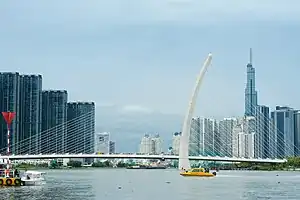Saigon River
The Saigon River (Vietnamese: Sông Sài Gòn) is a river located in southern Vietnam that rises near Phum Daung in southeastern Cambodia, flows south and south-southeast for about 225 kilometres (140 mi) and empties into the Soài Rạp, which in its turn empties into the South China Sea some 20 kilometres (12 mi) northeast of the Mekong Delta.



The Saigon River is joined 29 kilometres (18 mi) northeast of Ho Chi Minh City (formerly named Saigon) by the Đồng Nai river, and just above Ho Chi Minh City it is joined by the Bến Cát River. Saigon River is important to Ho Chi Minh City as it is the main water supply as well as the host of Saigon Port, with a total cargo volume loaded and outloaded of more than 35 million metric tons in 2006.
The Bình Quới Tourist Village is located on the Thanh Da peninsula on the Saigon River, in the Bình Thạnh District of Ho Chi Minh City.
Thủ Thiêm Tunnel, an underwater tunnel passing below the Saigon River, was opened to traffic on November 20, 2011. Since its completion, it has been the longest cross-river tunnel in Southeast Asia.[1] The river is also crossed by the Thu Thiem Bridge, Thu Thiem 2 Bridge, and Phu My Bridge.[2]
The Saigon Waterbus service launched in 2017, connecting District 1 with Thu Duc District.[3]
See also
References
- "The longest cross-river tunnel in southeast Asia" Archived 2013-10-22 at the Wayback Machine 2011 Thanh Nien News
- "Ho Chi Minh City's $133mn Thu Thiem 2 Bridge opened to traffic". Tuoi Tre News. 2022-04-28. Retrieved 2022-08-31.
- "Finding Fun and Revelation Aboard Saigon's Wayward Waterbus | Saigoneer". saigoneer.com. Retrieved 2022-08-31.
External links
- "Photos of the Saigon River - View from District 2 (An Phu and Thao Dien Wards)". SaigonNezumi.com. Archived from the original on 1 October 2011. Retrieved 4 August 2013.
- Toàn cảnh sông Sài Gòn River